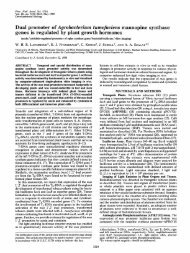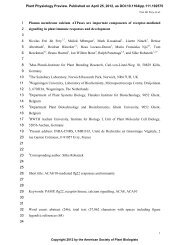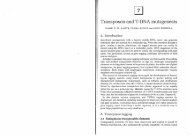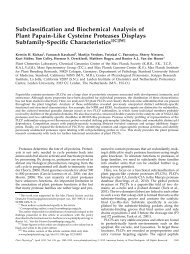A Conserved Domain of the Arabidopsis GNOM ... - The Plant Cell
A Conserved Domain of the Arabidopsis GNOM ... - The Plant Cell
A Conserved Domain of the Arabidopsis GNOM ... - The Plant Cell
Create successful ePaper yourself
Turn your PDF publications into a flip-book with our unique Google optimized e-Paper software.
348 <strong>The</strong> <strong>Plant</strong> <strong>Cell</strong><br />
Developmental and Subcellular Distribution <strong>of</strong><br />
Cyp5 Protein<br />
We raised an antiserum against a nonconserved Cyp5 C-terminal<br />
oligopeptide (see Figure 6) to determine <strong>the</strong> developmental<br />
expression and subcellular distribution <strong>of</strong> Cyp5. As<br />
shown in Figure 8A, <strong>the</strong> antiserum recognized a single<br />
band <strong>of</strong> 19 kD in siliques at high serum dilutions that was<br />
not detected by preimmune serum. <strong>The</strong> signal was diminished<br />
in a concentration-dependent manner by antiserum<br />
preincubation with <strong>the</strong> peptide antigen or <strong>the</strong> GST–Cyp5 19–201<br />
fusion protein, indicating specific recognition <strong>of</strong> <strong>the</strong> Cyp5<br />
protein (Figure 8A). <strong>The</strong> Cyp5-specific 19-kD band is consistent<br />
with <strong>the</strong> predicted molecular mass <strong>of</strong> 19.2 kD for<br />
<strong>the</strong> endoplasmic reticulum–processed Cyp5 protein, in<br />
contrast to <strong>the</strong> predicted 21.5 kD for <strong>the</strong> nonprocessed<br />
form. In vitro translation products <strong>of</strong> <strong>the</strong> nonprocessed and<br />
predicted processed form <strong>of</strong> Cyp5 showed <strong>the</strong> expected<br />
size difference (J. Gadea and G. Jürgens, unpublished results).<br />
Thus, Cyp5 appeared to be most abundant in its<br />
processed form.<br />
<strong>The</strong> Cyp5 protein was detected in several tissues, including<br />
flowers and siliques (Figure 8B). <strong>The</strong> subcellular distribution<br />
<strong>of</strong> Cyp5 was analyzed by differential centrifugation<br />
<strong>of</strong> extracts from suspension cells expressing a Golgi apparatus<br />
marker, Myc-tagged sialyl transferase (ST2-11; Wee<br />
et al., 1998). Cyp5 localized mainly to <strong>the</strong> cytosolic fraction<br />
but was also present in <strong>the</strong> membrane fraction (Figure 8C).<br />
By contrast, <strong>the</strong> sialyl transferase marker was confined to<br />
<strong>the</strong> microsomal pellet, indicating that microsomal membrane<br />
integrity was preserved during extraction. To determine<br />
whe<strong>the</strong>r <strong>the</strong> processed Cyp5 protein was secreted<br />
from cells, we analyzed <strong>the</strong> medium from a suspension cell<br />
culture (Figure 8D). Upon 280-fold concentration <strong>of</strong> <strong>the</strong> culture<br />
supernatant, secreted Cyp5 protein could not be detected,<br />
whereas a strong signal was found in <strong>the</strong> cell<br />
extract when equal amounts <strong>of</strong> total protein were loaded. In<br />
summary, Cyp5 c<strong>of</strong>ractionated with <strong>GNOM</strong> in cytosolic and<br />
membrane fractions, as would be required for <strong>the</strong>ir interaction<br />
in vivo.<br />
Figure 4. Specificity and <strong>Domain</strong> Mapping <strong>of</strong> Cyp5–<strong>GNOM</strong> Interaction<br />
in <strong>the</strong> Yeast Two-Hybrid System.<br />
(A) Interaction <strong>of</strong> <strong>the</strong> activation domain (AD)–Cyp5 fusion with different<br />
LexA–<strong>GNOM</strong> fragments (amino acid positions indicated). Activation<br />
<strong>of</strong> -Leu growth is indicated by or ; -galactosidase activity<br />
is given as arbitrary units. Error bars represent standard deviations<br />
from five independent transformants. LexA-bicoid (Bicoid) is <strong>the</strong><br />
negative control.<br />
(B) LexA–Cyp5 interaction with AD–<strong>GNOM</strong> subfragments (amino<br />
acid positions indicated). -Leu growth and -galactosidase assay<br />
are as given in (A).<br />
(C) Specificity <strong>of</strong> <strong>GNOM</strong>–Cyp5 interaction compared with o<strong>the</strong>r <strong>Arabidopsis</strong><br />
cyclophilins. LexA–<strong>GNOM</strong> fusion tested against AD fusions<br />
<strong>of</strong> full-length Cyp5, ROC1, ROC4, and AD vector pJG4.5 (Vector).<br />
-Galactosidase activity and growth on -Leu medium <strong>of</strong> two transformants<br />
streaked on plates and grown for 3 days are shown.<br />
Cyp5 Protein Localization in Embryogenesis<br />
<strong>The</strong> Cyp5 protein was detected by indirect immun<strong>of</strong>luorescence<br />
in <strong>the</strong> developing embryo from <strong>the</strong> early globular<br />
stage, as shown in Figure 9. As a control for <strong>the</strong> specificity<br />
<strong>of</strong> <strong>the</strong> signal, embryos were stained with <strong>the</strong> preimmune serum<br />
and with <strong>the</strong> antiserum preincubated with native GST–<br />
Cyp5 19–201 protein. In both cases, no specific signal was observed<br />
(Figure 9A; data not shown). Early-globular-stage<br />
embryos gave a weak Cyp5 signal in all cells, displaying a<br />
punctate distribution in <strong>the</strong> cytoplasm (Figure 9B). At <strong>the</strong> late<br />
globular/transition stage, <strong>the</strong> signal became more intense in<br />
all cells (Figure 9C). From <strong>the</strong> early heart stage, epidermal<br />
cells displayed less Cyp5-specific staining than did <strong>the</strong> inner<br />
cells (Figure 9D), and this lessening <strong>of</strong> staining became






